
Lithops is a genus of succulent plants in the ice plant family, Aizoaceae. Members of the genus are native to southern Africa. The name is derived from the Ancient Greek words λίθος 'stone' and ὄψ 'face', referring to the stone-like appearance of the plants. They avoid being eaten by blending in with surrounding rocks and are often known as pebble plants or living stones. Lithops is both the genus name and the common name. The formation of the name from the Ancient Greek -ops means that even a single plant is called a Lithops.

Echeveria is a large genus of flowering plants in the family Crassulaceae, native to semi-desert areas of Central America, Mexico and northwestern South America.
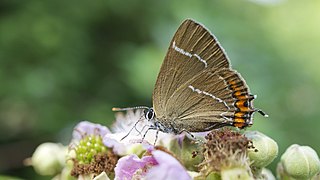
The white-letter hairstreak is a butterfly in the family Lycaenidae.

Cotyledon orbiculata, commonly known as pig's ear or round-leafed navel-wort, is a South African succulent plant belonging to the genus Cotyledon.
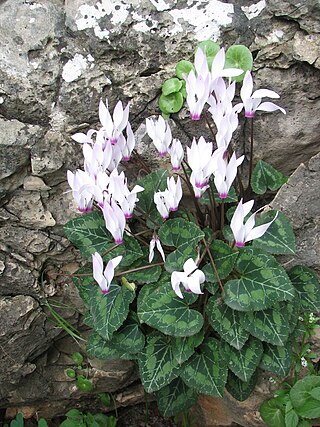
Cyclamen persicum, the Persian cyclamen, is a species of flowering herbaceous perennial plant growing from a tuber, native to rocky hillsides, shrubland, and woodland up to 1,200 m (3,900 ft) above sea level, from south-central Turkey to Lebanon-Syria and the Palestine region. It also grows in Algeria and Tunisia and on the Greek islands of Rhodes, Karpathos, and Crete, where it may have been introduced by monks. Cultivars of this species are the commonly seen florist's cyclamen.

Acer palmatum, commonly known as Japanese maple, palmate maple, or smooth Japanese maple (Korean: danpungnamu, 단풍나무, Japanese: irohamomiji, イロハモミジ, or momiji,, is a species of woody plant native to Korea, Japan, China, eastern Mongolia, and southeast Russia. Many different cultivars of this maple have been selected and they are grown worldwide for their large variety of attractive forms, leaf shapes, and spectacular colors.

Lithops viridis is a species of plant in the family Aizoaceae.

Echeveria agavoides, or lipstick echeveria, is a species of flowering plant in the family Crassulaceae, native to rocky areas of Mexico, notably the states of San Luis Potosí, Hidalgo, Guanajuato and Durango.

Haworthia magnifica is a species of the genus Haworthia belonging to the family Asphodelaceae.

Lithops francisci, commonly known as one of the living stones or pebble plants, is in the family Aizoaceae. It is endemic to the arid desert environments of Namibia. It is a succulent with a natural habitat in rocky areas. L. francisci was assessed by Nicholas Edward Brown in 1925. It is one of the Lithops plants and shares the characteristic bi-leaf head pattern separated by a deep fissure, the bottom of which houses and protects the stunted stem.

Larryleachia cactiformis is a stapeliad succulent, native to the Richtersveld and Namaqualand in South Africa, where it grows in rocky areas. Larryleachia cactiformis proves as difficult a member of the family Apocynaceae in cultivation as others in its genus.
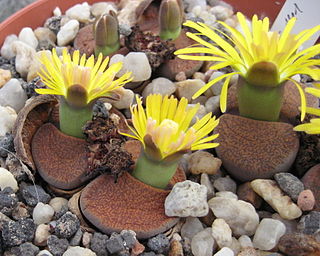
Lithops lesliei is a species of plant in the family Aizoaceae. The plant is collected for its medicinal properties, and has therefore become threatened.

Lapidaria is a monotypic genus of dwarf succulent plants in the family Aizoaceae. The only species it contains is Lapidaria margaretae, also known as the Karoo rose.
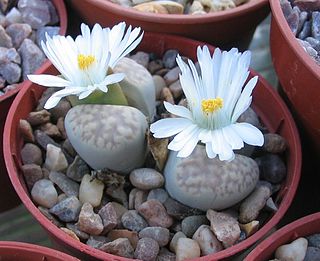
Lithops amicorum is a small succulent plant with white flowers, one of the smallest in the genus. It was named for the group of four friends who discovered it. It was collected by Desmond T. and Naureen A. Cole on 3 May 2004. After recent molecular analysis it was recombined to be a subspecies of Lithops karasmontana rather than its own species.

Leaf window, also known as epidermal window, and fenestration, is a specialized leaf structure consisting of a translucent area through which light can enter the interior surfaces of the leaf where photosynthesis can occur. The translucent structure may include epidermal tissue, and in some succulent plants it consists of several cell layers of parenchyma, which may also function as water-storage tissue. It can appear as a large continuous patch, a variegated or reticulated region, or as numerous small spots. It is found in some succulent plants native to arid climates, allowing much of the plant to remain beneath the soil surface where it is protected from desiccation by winds and heat while optimizing light absorption. Many species featuring leaf windows are native to Southern Africa.

Lithops localis is a species of plant in the family Aizoaceae, indigenous to South Africa.
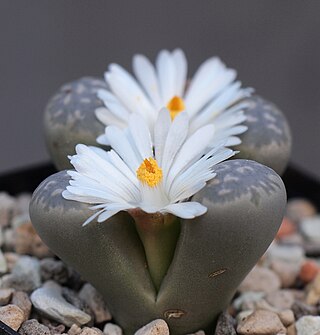
Lithops marmorata is a species of succulent pebble plant. It is native to the Northern Cape Province of South Africa. The specific name is derived from the Latin word marmorata meaning "marbled".
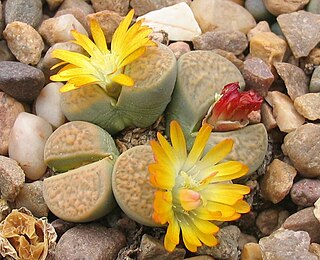
Lithops divergens is a succulent plant species in the genus Lithops of the family Aizoaceae. It is endemic to the western Cape Provinces of South Africa. It is able to withstand intense climatic changes due to its resilience as a succulent. The average annual rainfall for its natural environment is less than 150 mm, occurring primarily in winter which is unusual for a Lithops.
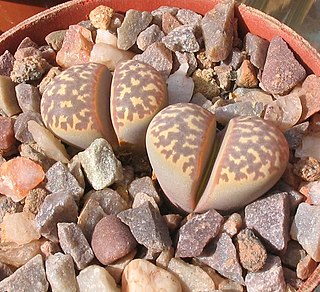
Lithops naureeniae is a species of pebble plant (Lithops), in the family Aizoaceae. It is native to the Northern Cape province of South Africa. The succulent is adapted to the desert climate in which it lives. L. naureeniae was identified in 1980 by Desmond Cole, who became involved in Lithops research in 1947, from a specimen provided to him by Bruce Bayer, curator of the Karoo Botanic Garden, having been collected by Peter V. Bruyns in Namaqualand. It is named after Cole's wife, Naureen Cole. Cole wrote:
I therefore have pleasure in dedicating it to the person who, during the last fifteen years, directly and indirectly, has contributed more to research on and knowledge of the genus Lithops than any other—my wife, Naureen

Lithops meyeri is a species of living stone (Lithops), under the family Aizoaceae. It is native to the Northern Cape province of South Africa. It is named after Rev. Gottlieb Meyer.






















